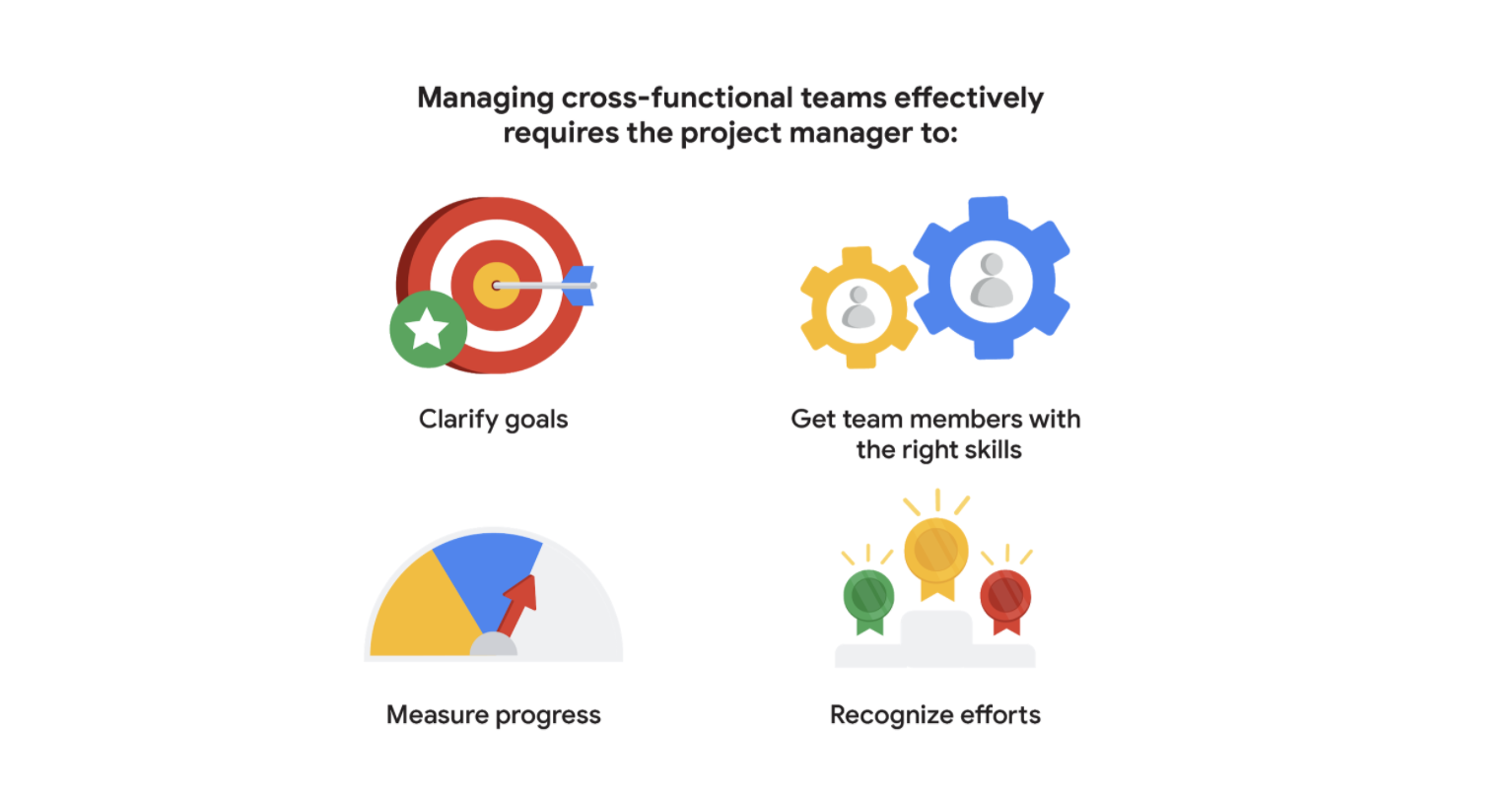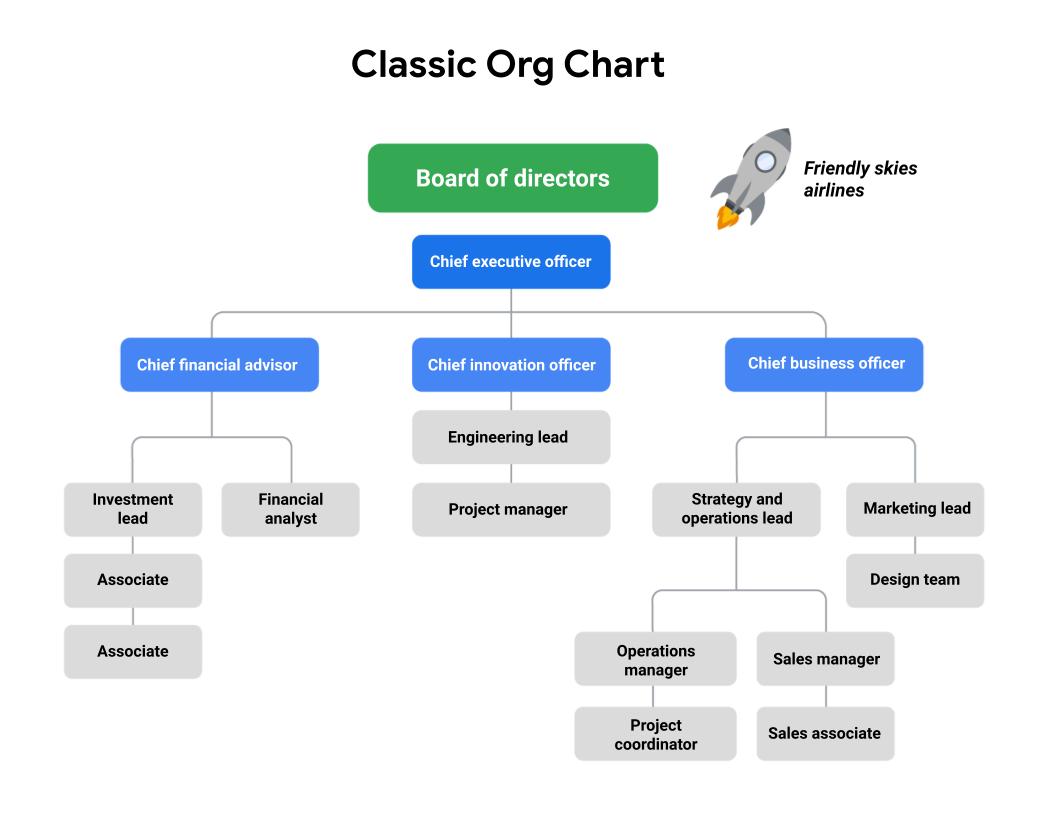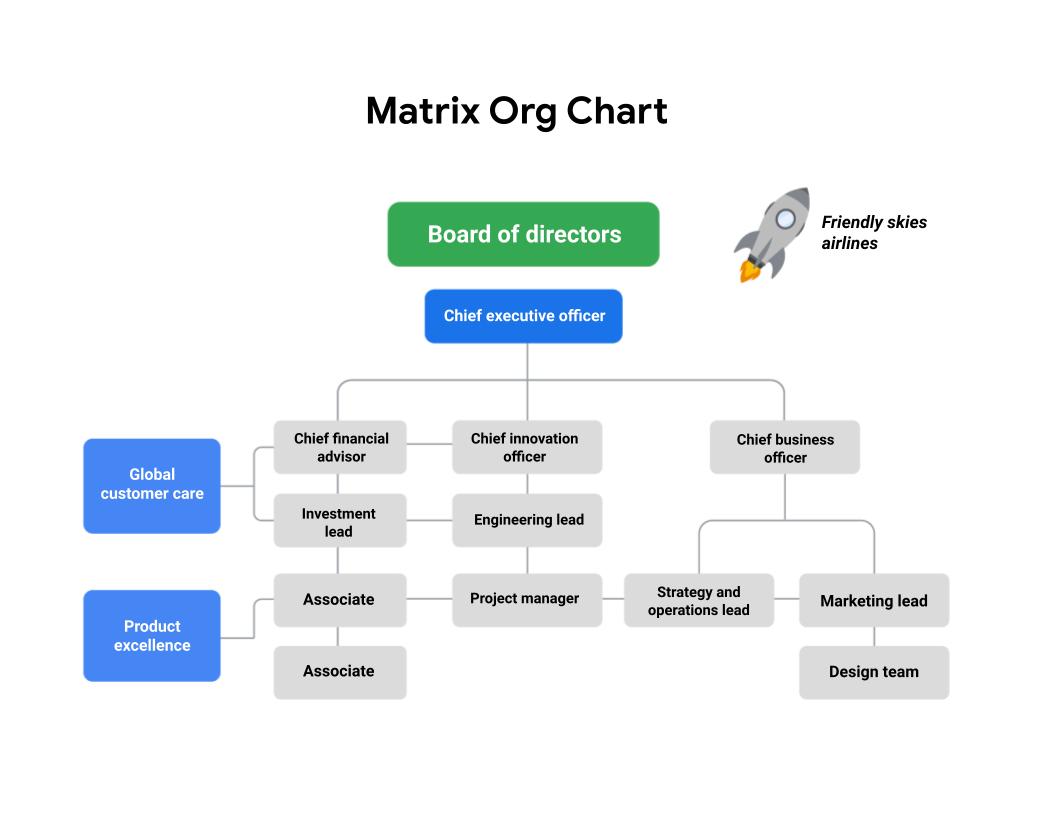
Week 1 - Embarking on a career in project management
Week 2 - Becoming an effective project manager
Key Project Manager Roles and Responsibilities
Project Management Responsibilities
- Planning and organising.
- Making use of productivity tools and creating processes.
- Creating plans, timelines, schedules, and other forms of documentation to track project completion.
- Managing tasks.
- A project tasks is an activity that needs to be accomplished within a set period of time by you, your team or your stakeholders.
- Budgeting and controlling costs and other factors.
- Monitor and manage the budget.
- Track issues and risks.
- Manage quality.
Managing barrier. By barriers, we mean things that can get in the way of project progress. For example, if your teammates lack the resources needed to complete a task, you might identify that issue, or barrier upfront, escalate the issue to a stakeholder, and work to secure the resource so your team can move forward.
Responsibilities that utilise interpersonal skills

Interpersonal Skills
- Communication
- Active Listening
- Leadership
Project Managers may be responsible for teaching and mentoring project team members, building relationships with the team and various stakeholders, controlling change and the impact to the project, empowering team members to make decisions, and communicating status and potential concerns. These interpersonal responsibilities can be just as important to the success of your projects as your more concrete responsibilities, like scheduling and budgeting.
A Project Manager’s Role within a Team
A Project Manager is not often the direct manager of the people working on a project team. Each person will be an expert on their portion of the project, but no one will be an expert on every aspect of the project.
- Hold all team members accountable for their assigned tasks
- Ensure that issues and risks are tracked and visible, and establish escalation path.
- Escalation Path means you should know how you will communicate risks to the right people at the right time.
- Understand and help teammates to adopt the right workflows and project management styles.
- Collaborate with other teams at the organisation to deliver solutions that meet the requirements based on project scope, schedule, and budget.
A project manager isn’t always the direct manager of each member of the project team. Rather, they’re responsible for guiding those people and ensuring they have the support they need to complete the project.
Working with Cross-Functional Teams

Being able to communicate clearly with team members, clarify the goals of the project, get team members with the right skills, measure team progress, and recognise team members’ efforts is an important part of your role as the project manager, and is key to your project’s success.
Core Skills of a Project Manager
- Enabling decision making.
- You can help team members free empowered from the start of your project by making the decision-making process collaborative.
- Empowering your team to express their opinions and make their own decisions allows you to focus on the overarching management tasks and prioritise them in order of importance.
- Additionally, when your allow team members to have voice in decisions, it helps foster an environment of responsibility, accountability, and team closeness.
- Communicating and escalating
- Project management requires clearly communicating project goals and expectations, team members roles and responsibilities and constructive feedback.
- KNowing how to effectively communicate and when to escalate issue to management is key to keeping you, your team, and your organisation on the path to success.
- When escalation is required, try to approach management with both the problem and potential solution or suggestions.
- Strong organisational skills
- Planning and scheduling software (templates, workflows, calendars)
- Collaboration tools (email, collaboration software, dashboards)
- Documentation (files, plans, spreadsheets)
- Quality assurance tools (evaluations, productivity trackers, reports)
- Flexibility
- ‘The only constant is change’
Key Competencies: Flexibility and Handing Ambiguity
All project managers need the ability to adopt and overcome changes and challenges. Flexibility is such a critical project management skill and it can help prepare your team for change, mitigate risks, and handle ambiguity.
Flexible Planning
The following flexible planning strategies can help you manage your project during time of unpredictability
- Assess external constraints. When planning your project, take external events into account, such as national holidays and team members vacations and sick leave. Leaving extra time in the schedule for these inevitable events up front can help minimise the impact to your project.
- Plan for risks and changes. If you consider the risks that may occur, you may be able to find solutions for them in advance. You can also assess risks by looking at historical data. Review your paste projects and examine the challenges you faced.
- Calculate float in your schedule. Float, or slack, refers to the amount of time you can wait to begin a tasks before it impacts the project schedule and threatens the project outcome. Identifying float in your schedule can help with resource management, scheduling, and keep your project on track.
Handling Ambiguity
- Keep calm.
- Express empathy.
- Communicate what you know clearly.
- Make decisions and stick to them.
- Trust the expertise of your team.
As a project manager, having the flexibility and ability to handle ambiguity in a rapid-changing business setting gives you an advantage. Mastering these competencies, along with enabling decision-making, effective communication skills, and strong organisational skills, will allow you to be innovate and grow as a project manager and leader.
Leadership & Team Dynamics
A project manager’s ability to guide teammates to complete their assigned work without acting as their direct managers.
- Communication
- Check-in with teammates to understand how they’re progressing on a task, and providing clear feedback on the quality of a teammate’s work.
- Negotiation
- Working with a teammate to compromise on a new deadline when they tell you that they won’t be able to complete their work on time.
- Conflict mediation
- Conflict mediation is a great skill to practice and develop to ensure the project does not suffer as a result.
- This might involve setting up a meeting with two teammates who are struggling to agree upon the best way to handle a shared tasks.
- Understanding motivations
- Getting to know your teammates and figuring out what pushes them to do their best work.
- Understanding motivations might also include learning how your teammates prefer to receive feedback, and how they like to receive recognition for doing a great job.
Important Interpersonal Skills for Project Management
- Enabling decision making. The ability to enable decision making on the team, or gather decisions from the appropriate leader is crucial to keep projects on task and achieve their goals. As a project manager, you will need to enable decisions frequently.
- Communicating and escalating. As a project manager, you’ll use your communication skills in just about everything you do. And you need to know when it is appropriate to escalate, so that critical issues are raised and addressed as soon as possible to reduce negative impact on a project.
- Remaining flexible. As a project manager, knowing how to be flexible when changes are needed is key. Plans will change — even with careful, upfront planning. As a project manager being flexible is critical to be able to course correct and adapt when the unexpected happens.
- Organizational Skills. Having strong organizational skills means having the ability to organize the core elements of a project and ensure nothing gets lost or overlooked. A project manager needs to be organized so that they can manage a project and all of its moving parts.
- Negotiation. As a project manager, you’ll have to know how to balance the needs of your teammates with the needs of the project. For example, if a teammate says they can’t complete their work on time, you may need to compromise on a deadline.
- Conflict mediation. Resolving tension and conflict within a team is an important skill. This may involve setting up a meeting with two teammates that are struggling to agree upon the best way to handle a shared task.
- Understanding motivations. Getting to know your teammates and figuring out what pushes them to their best work is an effective skill to have. Understanding motivations also involves understanding how your teammates prefer to receive feedback.
Week 3 - The Project Management Lifecycle and Methodologies
Week 4 - Introduction Organisational Structure and Culture
Objective
- Define organisational structure and organisational culture, and explain how they impact project management.
- Identify common types of organisational structure.
- Define change management and summarise its relationship to the project management role.
Overview of Classic and Matrix Structures
Organisational Structure
- The way a company or organisational is arranged.
- It also tells you how job tasks are divided and coordinated
- How all the different members of the organisation relate to one another.
- Different types of organisational structures can serve as a map to help you determine where you fit in, who you should communicate with, and how frequently to communicate with them.
Classic Structure: Traditional top-down hierarchy structures
- Chief Executive Officer (CEO) had direct authority over several department managers. Department managers has direct authority over several other sections of employees.
- Classic organisations are also referred to as functional organisations, with a clear chain of command.
- Level of authority: less authority and a tight scope.
- Access to resources: Depend on the Functional Manager in their organisation to approve resources.

Matrix Structure: Direct higher-ups and stakeholders from other departments or programs
- You still have people above you, but also have people in adjacent departments with whom you will need to communicate on your work progress.
- A more complex network of reporting
- Level of authority: Have to cooperate with other leaders in their organisation and may have less direct authority over their team members.
- Access to resources: May need to share project resources and negotiate priorities with other groups.

Project Manager vs Functional Manager
Project Manager’s Responsibilities
- What is to be done?
- When will the task be done?
- Why will the task be done?
- How much money is available to do the task?
- How well has the total project been done?
Functional Manager’s Responsibilities
- How will the task be done?
- Where will the task be done?
- Who will do the task?
- How well has the functional input been integrated into the project?
Another way of stating the roles is
- Project Manager is responsible for the overall integration of the total project system
- Functional manager is responsible for technical direction in his discipline.
Takeaway
- In both Classic and Matrix organisations, project manager must clearly define roles and responsibilities in order to work effectively. However, within most Matrix organisations, some project managers or department leads may have the same level of authority as the functional managers and operate more directly.
- More detailed overview about Matrix organisation
- It’s important for a Project Manager in a Matrix organisation to clearly define roles and responsibilities
- Because employees may report to more than one person and have multiple responsibilities across teams
- Because Project Managers can have the same level authority as Functional Managers
- Since Classic structures have a clear chain of command and Matrix structures do no, the process for getting approvals in these organisational structures differs
- A Project Manager in a Classic structure may have to get approval from the appropriate managers, directors, and department heads in order to complete certain tasks
- A Project Manager in a Matrix organisation, on the other hand, may have more autonomy to make decisions for the project as needed.
Understanding the Impact of Organisational Culture
Organisational Culture
An organisation’s culture provides context and acts as a guide for
- what their people value
- how they operate on a daily basis
- how they relate to one another
- how they can be expected to perform
Organisational Culture is in part the values employees share, as well as the organisation’s values, mission, history, and so on. In other words, organisational culture can be thought of as the company’s personality.
An organisation’s mission and values provide clues to its culture. Cultures guides what an organisation’s people value, how they operate, how they relate to one another, and how they can be expected to perform.
Navigate Culture
- Ask questions
- Make observations
- Understand your impact. Be aware of your role as a ‘Change Agent’
- Change Agent: A person from inside an organisation who helps the organisation transform by focusing on improving organisational effectiveness and development.
Understanding Change Management
Change Management: the process of delivering your completed project and getting people to adopt it.
- It’s important to recognise that it’s the people in an organisation who are directly impacted by any changes in the workplace.
- It’s important to keep in mind the changes that people will need to implement as a result.
Change Management in Project Management is center with three core concepts and best practices.
- Create a sense of ownership and urgency.
- Let others feel they are empowered to take responsibility for the successful completion of their tasks.
- Urgency means getting them to understand that the project is important and to identify what actions need to be taken to move the project along.
- With a sense of ownership and urgency around a project, it increase interest, motivation, and engagement with the project outcome.
- Figure out the right combination of skills and personalities.
- Effective communication.
- Having effective communication with your team means being transparent, upfront with your plans and ideas, and making information available.
- Motivate your team with clearly communicate your vision and approach for the project.
How to handle push-back?
- Help folks adjust with the change
- Reward their efforts
- Remind them of the overall value the project is providing long-term
Integrating Project Management and Change Management
As a Project Manager, you can think of change management as necessary for the successful outcome of your project. Both change management and project management aim to increase the likelihood of project success.
When thinking about change management related to your project, begin by asking yourself the following questions?
- How will the organisation react to change?
- Which influencers can affect change?
- What are the best means of communication?
- What change management practices will lead to the successful implementation of my project?
There are some Best Practices for approaching Change Management on your project
- Be proactive.
- Proactive and inclusive change management planning can help keep any potentially impacted stakeholders aware of the upcoming changes.
- Incorporate change management into your project management steps.
- Plan steps towards the end of your project to introduce the deliverable to stakeholders in the form of demonstrations, question and answer forums, or make videos.
- Communicate about upcoming changes.
- Communication should occur regularly among impacted stakeholders, the change management team, and the project team.
- Check-in and communicate throughout the project about how the changes will provide a better experience for end users of the project deliverables.
- Follow a consist process.
- Following a clear change management process helps maintain consistency each time there is a change.
- Change Management Process should be established and documented early on your project to guide how the project will handle change.
- when the promotion of change should happen
- when training should occur
- when the launch or release will occur
- corresponding steps for each phase of the process
- Practice empathy.
- Changes are inevitable, but we are often resistant to them.
- By being empathetic to the challenges and anxiety change can bring, you can support the process in subtle ways.
- Use tools.
- Feedback mechanisms, such as survey, can capture information from stakeholders.
- Flowchart can visualise the project’s development process.
- Culture mapping can illustrate the company’s culture and how the company’s values, norms, and employees behaviour may be affected by the change.
Project Governance
An Organisation align its project governance with its corporate governance
- By considering the long-term and short-term interests of the organisation.
- Leaders and stakeholders are more likely to support the project if it aligns with the overall interests and objectives of the organisation.
- Good project governance also includes making thoughtful decisions about what projects to start and clear communication with stakeholders.
- By making thoughtful decisions about which projects to take on and avoiding projects it they don’t have sufficient resources.
- An organisation should careful select projects and avoid projects if there are insufficient resources to make them sustainable.
- By providing stakeholders with timely, relevant, and reliable information.